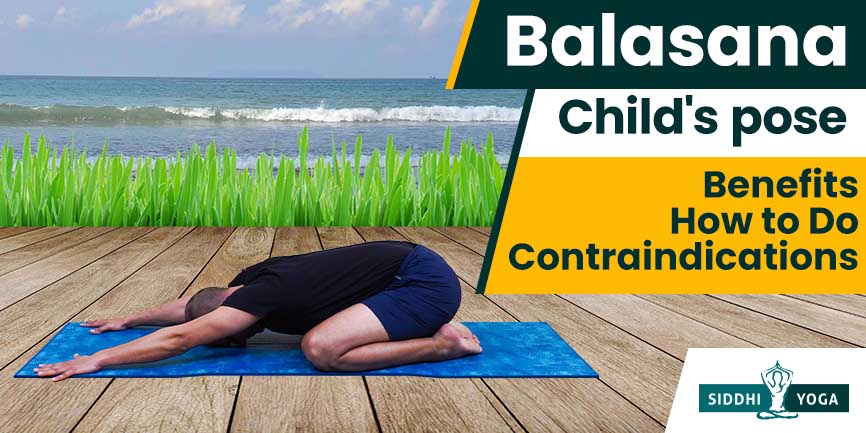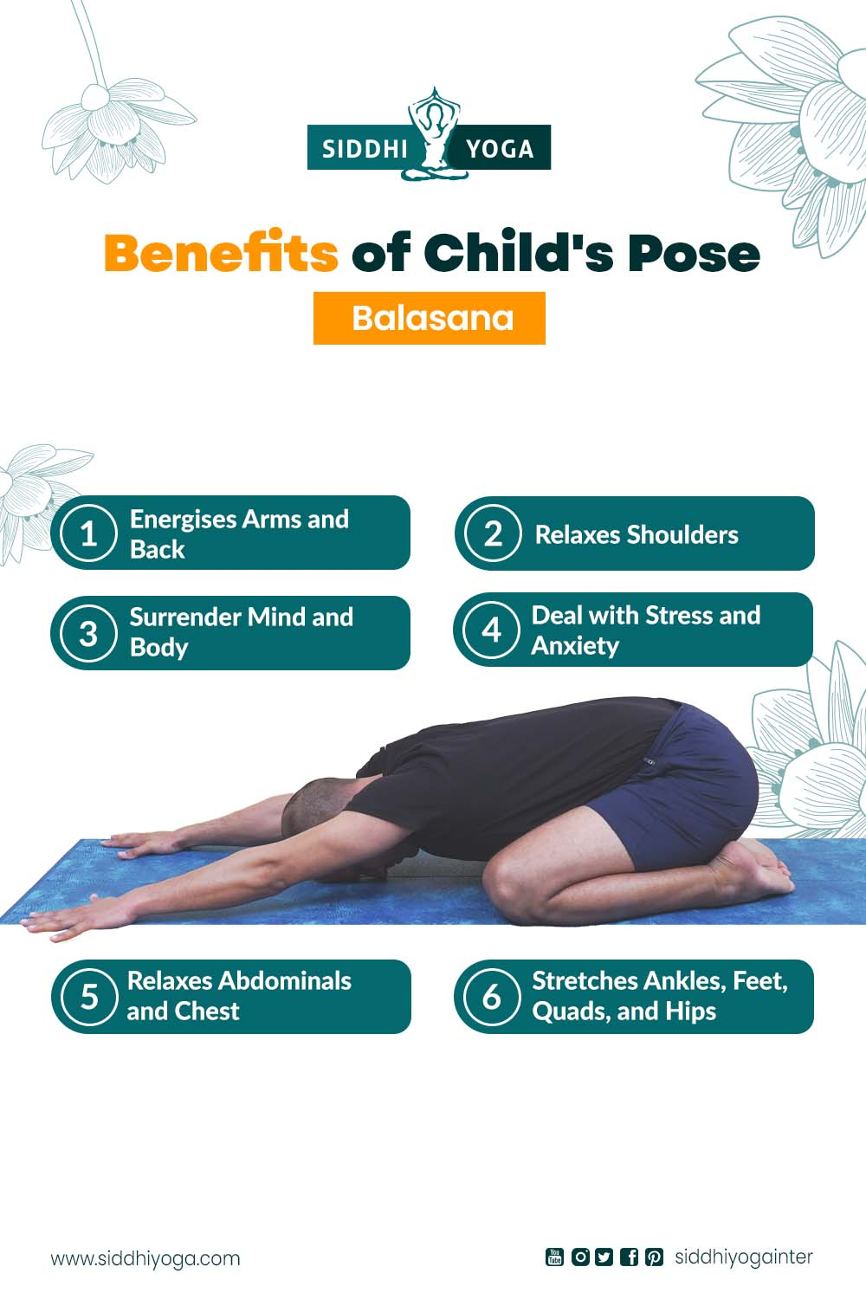
Bala = Child
Asana = Pose; Posture
Balasana at a Glance
Balasana or the Child pose is mostly done to relax our body, mind, and soul. This asana is mostly done after any back bend poses to counteract (neutralize) the effects of the pose.
Benefits:
- The best is it serves as the counter pose for the back bend pose.
- It relaxes your whole body, from the crown of your head to your toes.
- It soothes your body mind and soul.
- It fixes your digestion issues.
Who can do it?
Balasana being a simple and relaxing pose can be done by any age group from kids to people of 60 or sixty plus. Pregnant women can do it, but under the supervision of their prenatal yoga teacher or after consulting their health care professional.
Who should not do it?
People suffering from any knee, or ankle injury should avoid it. If any recent surgeries can alleviate the pain or make you feel discomfort, avoid it. People with severe back pain and very high blood pressure should avoid it. Pregnant women during their later period of pregnancy should avoid doing it.
How to Do Balasana?
Follow the Step-by-Step Instructions
This could be done as a restorative pose before finishing your yoga session to relax or could be done as one of the asanas and it can also be a part of the ‘Vinyasa flow sequence’. There are many ways reasons to include this child’s pose in your routine and the best part is the benefits you earn out of it.
- See that the floor that you are doing the asana has a yoga mat or anything soft base that doesn’t hurt you or disturb the flow.
- Come to the tabletop pose, feel the stretch, and be grounded and balanced. Inhale and exhale and bring your hips on your heels (sit on your heels).
- Your toes should touch each other and remember to keep your knees apart as this asana is about relaxing and comfort.
- Now, inhale deeply and slowly. You can close your eyes to feel your breath.
- Elongate your spine and stretch as much as your body allows. Exhale and slowly bend forward from your hip and your belly should be between your knees, which is a comfortable position.
- Keep your arms forward or along your sides. Whichever way you place your arms, keep it relaxed.
- Let your shoulder and neck be relaxed. Your forehead should be placed on the mat. If you feel some kind of pain, then place a soft cushion or a folded blanket under your forehead and enjoy the pose.
- Close your eyes, keep breathing slowly and feel the breath. Relax yourself physically as well as mentally. This is the best pose to meet your inner self.
- Be in this pose as much as you can and to get back, slowly open your eyes and come back to the physical world.
- Inhale and lift your body, sit on your heels, place your palms on the floor, and return to the tabletop pose.
- Continue this pose for the second round if needed.
- Breath and the child’s pose can create magic, so let both go hand in hand and very important to adjust your body according to your comfort and use props if needed.
What are the Benefits of Balasana?
It looks very simple and childish, and yes, it is known as the ‘child’s pose –Balasana’. It has great benefits and the best is that you can feel yourself and relax like a child.

- As you start this pose, it helps you to be grounded and balanced.
- Balasana helps you to stretch your back and strengthen your spine.
- This can relieve neck and shoulder pain and add more flexibility.
- This also helps with the lower back pain.
- The child’s pose gently massages your belly area, which helps in digestion and also helps with bloating and gas.
- As you breathe slowly, it relaxes and soothes your internal organs, leaving you calm and helping you to focus better.
- Balasana is a good counter pose for backbend asanas.
- It opens up your physical and mental obstruction and gives you more clarity about yourself.
Health Conditions that Might Benefit from Balasana
Mild Back Issues
It can help fix your mild back pain due to your work at home or in the office.
Headache
As this is a relaxing and calming pose, consistent practice of this asana can greatly help with mild headaches caused in your personal or workplace or extensive travel. knee injury
Digestion
Digestion issues affect your mental peace. Regular practice of Balasana can improve your mild digestive issues due to an unhealthy lifestyle.
Stiffness in Neck and Shoulders
The forward bend motion stretches and reduces stiffness in your neck and shoulders and is helpful for people working with computers.
Menstrual Pain
A child’s pose can help you with the menstrual cramps and promote relaxation.
Insomnia
It helps with better blood circulation, which has a soothing and calming effect and can help you get better sleep.
High Blood Pressure
The relaxing pose can help keep High BP in control.
Mental Health
This child’s pose keeps your mind and body calm, which supports your overall mental health.
Safety and Precautions
- If you have a knee or ankle injury, be careful while entering and out of the pose. Use cushions or folded blankets for comfort. or consult your doctor.
- If you feel discomfort in your shoulders, keep your arms to your side for better support, or consult your health care professional.
- Pregnant women should spread their legs wider and should not press their stomach too much on the thigh. They can also use a cushion for more comfort.
- Modify the pose according to your comfort or consult your yoga teacher. Come out of the child’s pose and ease yourself if you feel pain while doing this asana.
- Don’t hold your breath; take slow and deep breaths.
- Don’t stay in the child’s pose for the time period your body allows you to, and don’t push yourself to stay longer.
- Listen and respect your body, don’t force it too much, and consult your health care professionals if needed.
Common Mistakes
- Even though it’s a resting pose, mistakes may happen.
- This is a relaxing pose. Avoid overstretching your arms too much. Keep your ears away from your shoulders and relax your neck and shoulder muscles. Don’t tuck your chin to the chest. Keep it natural.
- If you feel uncomfortable sitting on heels, just place a cushion or blanket to avoid strain.
- Avoid arching your lower back when stretching forward and lengthen your spine.
- If a particular position causes pain, don’t push it. Just come out of the pose.
- Modifications should be done only under the guidance of a yoga teacher.
Tips for Balasana
- Try staying in this pose for about 30 seconds (according to your comfort).
- Breathing is the key, focus on breathing gently and deep throughout the pose.
- Adjust your knees according to your comfort level.
- Release the tension from your shoulder and keep away from your ears.
- If you feel uncomfortable extending your arms keep them on your side to the rest of the floor.
- Use props for additional support and comfort.
The Physical Alignment Principles for Balasana
- When in the starting position (Table pose), see that your wrists are under your shoulders and knees under your hips to make yourself stable enough to start the pose.
- Seet that your hips are placed on your heels. This can give you a gentle stretch.
- Remember to lengthen your spine as the crown of your head reaches the ground.
- Widen your knees, place your torso between your thighs, and your forehead should be on the mat or a prop if using one.
- Arms should be relaxed on your sides or front, per your comfort.
- Use props like cushions, yoga blocks, or blankets for support if you feel your hips are stiff.
- Alignment is about fixing your body within a comfortable posture to get the best out of the pose.
Balasana and Breath
As Balasana is about resting and relaxation, without breath, it’s not possible. They should both work together. Settle in the pose, take deep and slow, relaxed breaths and feel them running throughout the body, energizing every part of your body. The breadth will guide you to stretch and extend your arms and back according to your body’s comfort, listen to the voice of your inner self, and follow with your breath to keep yourself calm and relaxed throughout the pose. This combination will soothe your mind and body to give you peace and satisfaction.
Balasana and Variations
- Extended Child Pose.
- Supported Child Pose.
- Thread the Needle Pose.
- Puppy Pose.
- Dynamic Child Pose.
- The child poses a twist variation.
- Happy Baby Pose.
Take Away
Balasana (child pose) can give you an experience of relaxation and calmness. It helps us to slow down in our busy, stressful lives. It reminds us about caring for our inner self by recharging our body and mind and preparing ourselves to face other challenges. It helps us to coordinate with our breath and to know more about ourselves. You may be a beginner or experienced, but Balasana teaches everyone to be still and pause to take care of your mental and physical well-being. You always don’t need complicated actions to take care of your overall well-being. Balasana could be a wonderful, simple and easy example of comfort and reconnecting with your breath.
Unlock the door to a fulfilling career in yoga instruction with our accredited yoga teacher training courses. Choose from our foundational 200-Hrs Yoga Teacher Training Course, advanced 300-Hrs Yoga Teacher Training Course, or the all-encompassing 500-Hrs Yoga Teacher Training Course – all certified by Yoga Alliance, USA. Immerse yourself in the world of yoga philosophy, anatomy, teaching methodologies, and more. Embrace this opportunity to become a certified yoga instructor and inspire others on their path to wellness. Enroll now1 and embark on a transformative journey!
Responses